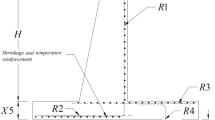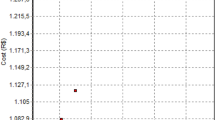Abstract
Sustainable design has become the top agenda among civil engineers to combat the rise of climate change. While computational advancements have enabled objective-based designs, sustainability requires a balanced optimization of a combination of cost, environmental, and safety factors. While metaheuristic algorithms have proven effective for multi-objective optimization, researchers are uncertain which objectives should be considered for sustainable design. Thus, this study conducts a comparative evaluation of six objective functions (three single-objective and three multi-objective) using the genetic algorithm to enhance the sustainability of design for a reinforced concrete cantilever retaining wall. The study explores material cost, carbon emissions, and embodied energy functions, with the latter investigated for the first time for retaining walls. It is revealed through a graphical analysis that cost and energy are superior objectives for sustainability, both individually and in combination. Conversely, the carbon emission objective has relatively adverse effects on the overall sustainability of the retaining wall.





Similar content being viewed by others
Data availability
The data used in this study has been presented within the article.
References
Intergovernmental Panel on Climate Change (IPCC), Global Warming of 1.5°C. An IPCC special report on the impacts of global warming of 1.5°C above pre-industrial levels and related global greenhouse gas emission pathways, in the context of strengthening the global response to the threat of climate change, sustainable development, and efforts to eradicate poverty (2018). https://www.ipcc.ch/site/assets/uploads/sites/2/2019/06/SR15_Full_Report_High_Res.pdf. Accessed 28 Dec 2022
United Nations Environment Programme (UNEP), Emissions Gap Report (2020). https://www.unep.org/emissions-gap-report-2020. Accessed 28 Dec 2021
International Energy Agency (IEA), Net Zero by 2050: A Roadmap for the Global Energy Sector (2021). https://www.iea.org/reports/net-zero-by-2050. Accessed 28 Dec 2022
Structural Engineering Institute (SEI), A Vision for the Future of Structural Engineering and Structural Engineers: A Case for Change (2013). http://www.abece.com.br/pdf/A_vision_for_the_future.pdf. Accessed 28 Dec 2022
P. Hájek, C. Fiala, M. Kynčlová, Life cycle assessments of concrete structures—a step towards environmental savings. Struct. Concr. 12(1), 13–22 (2011). https://doi.org/10.1002/suco.201000026
A.B. Rohden, M.R. Garcez, Increasing the sustainability potential of a reinforced concrete building through design strategies: case study. Case Stud. Constr. Mater. 9, e00174 (2018). https://doi.org/10.1016/j.cscm.2018.e00174
European Concrete Platform (ECP), Sustainable Benefits of Concrete Structures (2009). https://www.theconcreteinitiative.eu/images/ECP_Documents/SustainableBenefitsConcreteStructures_EN.pdf. Accessed 28 Dec 2022.
S.A. Miller, A. Horvath, P.J.M. Monteiro, Readily implementable techniques can cut annual CO2 emissions from the production of concrete by over 20%. Environ. Res. Lett. 11, 074029 (2016). https://doi.org/10.1088/1748-9326/11/7/074029
V.J.L. Gan, I.M.C. Lo, J. Ma, K.T. Tse, J.C.P. Cheng, C.M. Chan, Simulation optimisation towards energy efficient green buildings: current status and future trends. J. Clean. Prod. 254, 120012 (2020). https://doi.org/10.1016/j.jclepro.2020.120012
H. Brooks, J.P. Nielsen, Basics of Retaining Wall Design: A Design Guide for Earth Retaining Structures, 10th edn. (HBA Publications, Newport Beach, 2013)
T. Dede, M. Kripka, V. Togan, V. Yepes, R.V. Rao, Usage of optimization techniques in civil engineering during the last two decades. Curr. Trends Civ. Struct. Eng. 2(1), 1–17 (2019). https://doi.org/10.33552/ctcse.2019.02.000529
J.S. Arora, Introduction to Optimum Design, 4th edn. (Academic Press, Waltham, 2016)
M. Shakeel, R. Azam, M.R. Riaz, A. Shihata, Design optimization of reinforced concrete cantilever retaining walls: a state-of-the-art review. Adv. Civ. Eng. 2022, 4760175 (2022). https://doi.org/10.1155/2022/4760175
P. Villalba, J. Alcalá, V. Yepes, F. González-Vidosa, CO2 optimization of reinforced concrete cantilever retaining walls, in 2nd International Conference on Engineering Optimization, Lisbon (2010), pp. 1–10
H.T. Öztürk, E. Türkeli, Optimum design of reinforced concrete retaining walls with key section using Jaya algorithm. J. Polytech. 22(2), 283–291 (2019). https://doi.org/10.2339/politeknik.432031
C. Schmied, V. Karlsson, Optimization of Reinforced Concrete Cantilever Retaining Walls Considering Environmental Impact and Investment Cost. Dissertation, KTH Royal Institute of Technology (2021)
M. Khajehzadeh, M.R. Taha, M. Eslami, Multi-objective optimisation of retaining walls using hybrid adaptive gravitational search algorithm. Civ. Eng. Environ. Syst. 31(3), 229–242 (2014). https://doi.org/10.1080/10286608.2013.853746
A.E. Kayabekir, Z.A. Arama, G. Bekdaş, S.M. Nigdeli, Z.W. Geem, Eco-friendly design of reinforced concrete retaining walls: multi-objective optimization with harmony search applications. Sustainability 12(15), 6087 (2020). https://doi.org/10.3390/su12156087
G.P. Hammond, C.I. Jones, Embodied energy and carbon in construction materials. Proc Inst Civ Eng Energy 161(2), 87–98 (2008). https://doi.org/10.1680/ener.2008.161.2.87
D. Yeo, R.D. Gabbai, Sustainable design of reinforced concrete structures through embodied energy optimization. Energy Build. 43(8), 2028–2033 (2011). https://doi.org/10.1016/j.enbuild.2011.04.014
International Energy Agency (IEA), Evaluation of Embodied Energy and CO2eq for Building Construction (2016). http://www.iea-ebc.org/Data/publications/EBC_Annex_57_Results_Overview.pdf. Accessed 28 Dec 2022
R. Yu, D. Zhang, H. Yan, Embodied energy and cost optimization of RC beam under blast load. Math. Probl. Eng. 2017, 1907972 (2017). https://doi.org/10.1155/2017/1907972
M.A. Ismail, C.T. Mueller, Minimizing embodied energy of reinforced concrete floor systems in developing countries through shape optimization. Eng. Struct. 246, 112955 (2021). https://doi.org/10.1016/j.engstruct.2021.112955
G.P. Hammond, C.I. Jones, Inventory of Carbon and Energy (ICE), v3.0a (2019). https://circularecology.com/embodied-carbon-footprint-database.html
L.F. Cabeza, L. Boquera, M. Chàfer, D. Vérez, Embodied energy and embodied carbon of structural building materials: worldwide progress and barriers through literature map analysis. Energy Build. 231, 110612 (2021). https://doi.org/10.1016/j.enbuild.2020.110612
I. Naeem, Structural Optimization of Retaining Wall Using Genetic Algorithms. Dissertation, University of Engineering and Technology (2016)
A.H. Gandomi, A.R. Kashani, D.A. Roke, M. Mousavi, Optimization of retaining wall design using evolutionary algorithms. Struct. Multidiscip. Optim. 55, 809–825 (2017). https://doi.org/10.1007/s00158-016-1521-3
P.E. Mergos, F. Mantoglou, Optimum design of reinforced concrete retaining walls with the flower pollination algorithm. Struct. Multidiscip. Optim. 61, 575–585 (2020). https://doi.org/10.1007/s00158-019-02380-x
S. Purohit, Multi-objective Optimization of Reinforced Cement Concrete Retaining Wall. Dissertation, National Institute of Technology (2014)
P. Rahbari, N. Ravichandran, C.H. Juang, Seismic geotechnical robust design of cantilever retaining wall using response surface approach. J. Geoeng. 12(4), 147–155 (2017). https://doi.org/10.6310/jog.2017.12(4).2
M. Kalateh-Ahani, A. Sarani, Performance-based optimal design of cantilever retaining walls. Period. Polytech. Civ. Eng. 63(2), 660–673 (2019). https://doi.org/10.3311/PPci.13201
M. Shakeel, R. Azam, M.R. Riaz, A spreadsheet-based tool for optimal design of reinforced concrete cantilever retaining walls. Innov. Infrastruct. Solut. 7, 109 (2022). https://doi.org/10.1007/s41062-021-00700-z
J. Waheed, R. Azam, M.R. Riaz, M. Shakeel, A. Mohamed, E. Ali, Metaheuristic-based practical tool for optimal design of reinforced concrete isolated footings: development and application for parametric investigation. Buildings 12(4), 471 (2022). https://doi.org/10.3390/buildings12040471
R. Azam, M.R. Riaz, M.U. Farooq, F. Ali, M. Mohsan, A.F. Deifalla, A.M. Mohamed, Optimization-based economical fexural design of singly reinforced concrete beams: a parametric study. Materials 15(9), 3223 (2022). https://doi.org/10.3390/ma15093223
M. Shakeel, R. Azam, M.R. Riaz, Genetic algorithm-based geometric and reinforcement limits for cost effective design of RC cantilever retaining walls. Struct. Eng. Mech. 86(3), 337–348 (2023). https://doi.org/10.12989/sem.2023.86.3.337
U. Ali, R. Azam, M. Shakeel, M. Adil, M.R. Riaz, A practical tool for structural design optimization of steel frames: development and application for parametric analysis. Innov. Infrastruct. Solut. 9, 3 (2024)
ACI Committee 318, Building Code Requirements for Structural Concrete and Commentary (American Concrete Institute, Farmington Hills, 2014)
R. Evins, A review of computational optimisation methods applied to sustainable building design. Renew. Sustain. Energy Rev. 22, 230–45 (2013). https://doi.org/10.1016/j.rser.2013.02.004
A. Stephan, R.H. Crawford, K. De Myttenaere, Towards a comprehensive life cycle energy analysis framework for residential buildings. Energy Build. 55, 592–600 (2012). https://doi.org/10.1016/j.enbuild.2012.09.008
L.J. Hurst, T.S. O’Donovan, A review of the limitations of life cycle energy analysis for the design of fabric first low-energy domestic retrofits. Energy Build. 203, 109447 (2019). https://doi.org/10.1016/j.enbuild.2019.109447
A. Stephan, R.H. Crawford, K. De Myttenaere, A comprehensive assessment of the life cycle energy demand of passive houses. Appl. Energy 112, 23–34 (2013). https://doi.org/10.1016/j.apenergy.2013.05.076
S.N. Sivanandam, S.N. Deepa, Introduction to Genetic Algorithms (Springer, Berlin, 2008)
O. Kramer, Genetic Algorithm Essentials, 1st edn. (Springer, Cham, 2017)
A. Slowik, H. Kwasnicka, Evolutionary algorithms and their applications to engineering problems. Neural Comput. Appl. 32, 12363–12379 (2020)
J.H. Holland, Adaptation in Natural and Artificial Systems (University of Michigan Press, Ann Arbor, 1975)
S.M. Ashraf, Practical Design of Reinforced Concrete Buildings (CRC Press, Boca Raton, 2018)
Palisade Corporation, Evolver v8.2 (version 8.2) (2021). https://www.palisade.com/evolver/default.asp.
J.C. McCormac, R.H. Brown, Design of Reinforced Concrete, 9th edn. (Wiley, Hoboken, 2013)
Z.A. Siddiqi, Concrete Structures Part-1, 3rd edn. (Help Civil Engineering Publishers, Lahore, 2018)
Funding
No funding or grant was received for this research.
Author information
Authors and Affiliations
Corresponding author
Ethics declarations
Conflict of interest
The authors report there are no competing interests to declare.
Ethics approval
Not applicable.
Consent to participate
Not applicable.
Consent for publication
Not applicable.
Additional information
Publisher's Note
Springer Nature remains neutral with regard to jurisdictional claims in published maps and institutional affiliations.
Rights and permissions
Springer Nature or its licensor (e.g. a society or other partner) holds exclusive rights to this article under a publishing agreement with the author(s) or other rightsholder(s); author self-archiving of the accepted manuscript version of this article is solely governed by the terms of such publishing agreement and applicable law.
About this article
Cite this article
Shakeel, M., Azam, R., Riaz, M.R. et al. Optimization-Based Design of Reinforced Concrete Cantilever Retaining Walls Considering Embodied Energy, Carbon Emissions, and Cost. J. Inst. Eng. India Ser. A (2024). https://doi.org/10.1007/s40030-024-00809-1
Received:
Accepted:
Published:
DOI: https://doi.org/10.1007/s40030-024-00809-1




